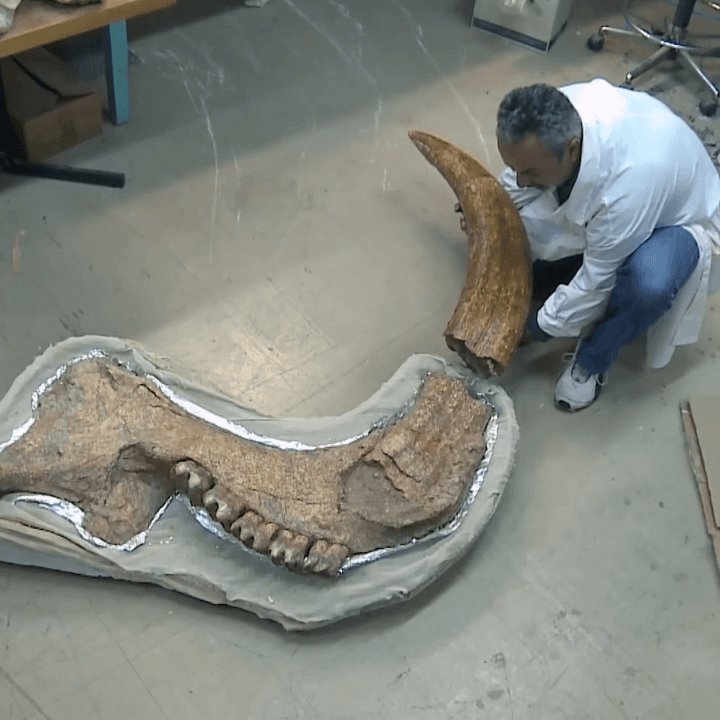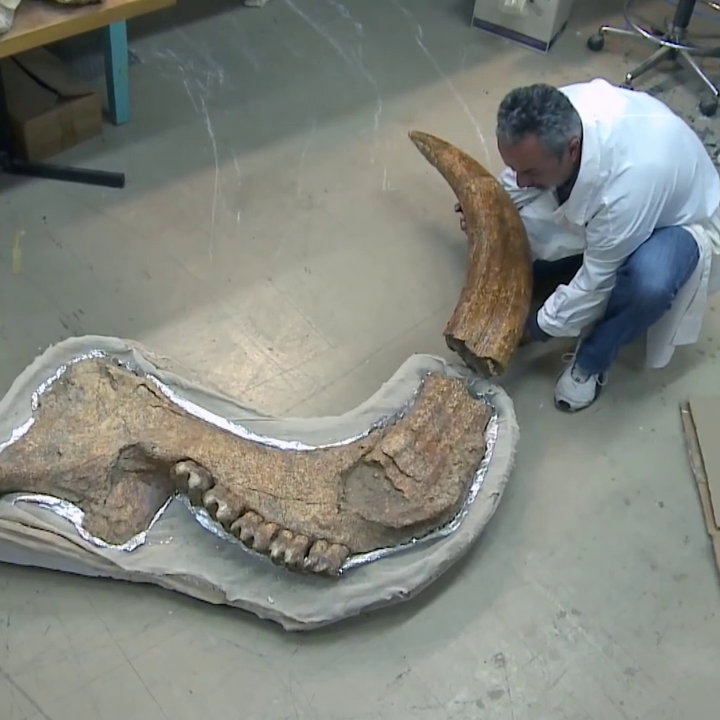Immediately after finishing my studies, my first job was for the Museum of Natural History. We went all over Crete holding events, summer activities, schools. So, we began to come into contact with a wider audience, to raise awareness of the museum, if you like. What we wanted to get across was that the museum isn’t just a place where you go to see two or three exhibits, but, behind the scenes there is research work, the collections, the excavations that we do.
One day, I got a call. As I was sitting in my office and the phone rang. A man on the other end of the line said, ‘I’m calling from Sitia. My daughter and I have been to the museum; we have visited with the children. Very nice’, etc., ‘And, you see, while walking with my daughter the other day here, outside our house, we think we found something interesting’.
‘What do you think it is?’
He replied, ‘It looks like a fossil. And to be honest with you, to me, it looks like a fossilised hoof’.
I said, ‘The hoof of what?’
‘A horse?’.
‘A fossilised horse hoof?’ I asked. ‘The don’t fossilise easily’.
‘What can I say?’ he replied, ‘That’s what it looks like to me. I don’t know… the large hoof of an ox, or a horse; that’s what the shape looks like. My daughter says it’s a tooth’.
‘Look’, I said, ‘if it’s a tooth, does it look like it has enamel on it, like our teeth’.
He said, ‘There is enamel’. And then he said, ‘Another thing, it seems like there are some other bones, long bones’.
I said, ‘Are you sure?’
Anyway, from the details he gave me, it seemed like it was something significant. So, I said, ‘Is it big?’ And he answered, ‘Like a fist’. Anyway, it was something significant. The whole story was interesting. So, I decided to go on a trip; to go from Heraklion to Sitia where they were.
Remember, Sitia was three hours away by car. Heraklion to Sitia, even today, is a bit of a hassle, and then we didn’t even have the northern road; we’re talking 2002... And, you know, sometimes you go all that way – and so many times I’ve done journeys of similar length – only to find it’s nothing, just a strange-shaped rock.
So, I got to Sitia, and the man took me to the spot, and said, ‘This is where it is’. There were bones lying on the surface. Some of them seemed very big to me. I mean, I was really surprised, because I’d never seen such big bones before. Basically, they’d all been cleaned by the rain. Probably the person who actually owned the land had used a bulldozer to level the ground a little; it seems he had reduced the slope and the rainwater had washed away the rocks in the section where he’d dug, and the bones, the fossils, had come to the surface.
The man showed me two pieces he’d found, and they were, indeed, two teeth. They were teeth the size of our fists, even bigger. To be honest, I had no idea what they were. I suspected that one might be a tusk. The one on the surface was broken. And so, this visit showed us that this was something very important.
However, when the landowner heard that something had been found there, he got scared and went and smashed them with a hammer. He smashed them to smithereens. He was worried that the Archaeological Service would come and schedule the site. They’re the strictest authority in Greece, and it’s difficult to get out of their clutches if you get sucked into something to do with archaeology. We began the excavation after we’d found the owner and managed to convince him that there was nothing to be afraid of. We explained to him that these were fossils and had nothing to do with archaeological finds: there is some confusion about fossilised and archaeological finds. There was nothing for him to worry about.
We dug there from morning ‘til night. In the dust, under the sun. We had some tents, because excavations are done in summer. When we were covered in dust, we would go for a dip in the sea. One time, we got a ticket from the traffic police for not wearing seatbelts. I mean, in the hundred metres from the dig to the beach, we got stopped by the police and got a ticket for seatbelts, because of the mess we were in. We said, ‘Can’t you see the state we’re in?’
Finally, it took several years for us to dig the whole of the area that covered the fossils, and we found almost all the animal’s teeth. There was just one we didn’t find. We found its two tusks; we didn’t find the skull, because the animal was quite an age; we decided about eight to eight and a half million years, really old in comparison to those we knew of on Crete. We ultimately found almost half the animal’s skeleton.
It was the last day, and we’d already collected a lot of bones, mostly ribs, vertebrae, one or two of the teeth that had been scattered, some parts of the extremities from the animal’s legs, and it was the last day of the dig. So, we said, ‘Let’s go as far as that section; let’s dig there. It’s a shame to leave it. And then we’ll pack up and go back to Heraklion’. So, on the afternoon of the last day that we were digging, we found a bone and slowly began to uncover it, to see how big it was and take it with us. It turned out to be the bottom jaw with its two tusks, the biggest and most impressive sample.
We were there until midnight, using the headlights of the cars while we dug it up, because we’d arranged to go; that was the end of it. We’d left the hotels and were ready to go. It was a hell of a job to clean it so that we could take it with us, because it was very heavy, about two, two and a half metres. So, we worked there until midnight under the headlights, so that we could extract it and take it with us. We arrived back in Heraklion around 2 or 3 in the morning if I remember correctly.
During our examinations, we recognised that these fossils belonged to what we call a ‘Deinotherium’, a giant Deinotherium, as they were called then. It was a nightmare to identify, because we didn’t know that this kind was found here on Crete. It was the first time that there’d been any evidence that there’d been an animal that wasn’t an elephant, but was an ancestor, some kind of relation to elephants, on Crete. We had no idea.
It was around four and a half metres tall and five and a half metres long. Probably the largest land animal that ever lived in Greece. There can’t have been a bigger animal than this on land, both as an individual and as a species. Of course, we should remember that Crete was nothing like the Crete we know today. Not even the Aegean was the Aegean that we know now. Crete was small islands, three or four small islands. It was a completely different environment with a lot of vegetation, a relatively tropical climate. I mean, with a lot of rain, high temperatures, thick vegetation, because this animal was a forest dweller. Basically, there was an environment then that could have supported it.
Finding this Deinotherium and the publicity it got helped us a lot, because – because of this – so many people phoned us. They contacted us about finds, things they had noticed. We got a lot of information, much of which was very important. We found new palaeontological sites with fossils of deer and hippopotamuses, which we already knew were on Crete. We enriched our collections with new samples and discovered more about the life on the island in prehistoric times.
It was amazing. I mean, one of those once-in-a-lifetime experiences in your subject or field. It was a really important discovery. Everyone in Sitia came by to watch us at the excavation site. They brought us sweets. It was the story at that time. By making comparisons with examples from abroad, we managed to put it together, and it’s now full size in our exhibition, as we think it looked, like some ancestor of the elephant. And that’s how something a child noticed while gathering wild greens ended up being possibly the largest species of land animal that ever lived in Greece.











